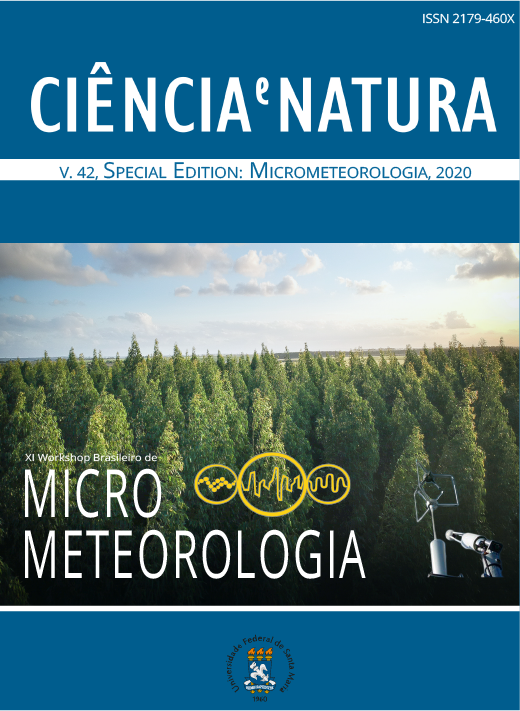Estudo do colapso da turbulência em um canal aberto estratificado
DOI:
https://doi.org/10.5902/2179460X45312Palavras-chave:
CFD, Camada Limite, TurbulênciaResumo
Logo após o pôr-do-Sol, a superfície terrestre inicia o seu resfriamento pela emissão de radiação de onda longa. Como resultado desse processo, as camadas de ar juntamente a superfície são resfriadas, desta forma origina-se uma camada limite estável (CLE). O presente trabalho tem como objetivo geral realizar uma simulação numérica de um escoamento turbulento e observar os efeitos da estratificação sobre o mesmo. Para a realização desse trabalho, foi feita a reprodução de um escoamento em um canal aberto devido ao fato da parede superior não influenciar no escoamento, no qual foi aplicado um gradiente de temperatura entre as placas inferior e superior. O software CFD utilizado no trabalho foi o OpenFOAM 2.4.0. O solver mais apropriado para o presente trabalho é o buoyantPimpleFoam, o qual é indicado para escoamentos compressíveis, turbulentos, transientes e com transferência de calor. Analisando os resultados encontrados, observa se que antes da realização do processo de estratificação térmica os níveis encontram-se acoplados em função da presença da turbulência. Quando isso ocorre, ocasiona uma maior homogenização da velocidade e temperatura na região central do domínio. Para grandes gradientes de temperatura observa-se uma laminarização do escoamento devido aos forçantes térmicos serem maiores que os mecânicos.
Downloads
Referências
HOLMAN, J. Heat Transfer of International Edition. [S.l.]: McGraw-Hill, New York, 2009.
HOLZMANN, T. Mathematics, Numerics, Derivations and OpenFOAM®. [S.l.]: Loeben, Germany:Holzmann CFD, 2016. Disponível em: https://holzmann-cfd. Acesso em: 29 nov. 2017
MAHRT, L.; VICKERS, D. Extremely weak mixing in stable conditions. Boundary-layer meteorology, Springer, v. 119, n. 1, p. 19–39, 2006.
PENTTINEN, O.; YASARI, E.; NILSSON, H. A pimplefoam tutorial for channel flow, with respect to different les models. Practice Periodical on Structural Design and Construction, v. 23, n. 2, p.1–23, 2011.
STULL, R. B. An introduction to boundary layer meteorology. [S.l.]: Springer, 1988. v. 13.
Downloads
Publicado
Como Citar
Edição
Seção
Licença
Para acessar a DECLARAÇÃO DE ORIGINALIDADE E EXCLUSIVIDADE E CESSÃO DE DIREITOS AUTORAIS clique aqui.
Diretrizes Éticas para Publicação de Revistas
A revista Ciência e Natura está empenhada em garantir a ética na publicação e na qualidade dos artigos.
A conformidade com padrões de comportamento ético é, portanto, esperada de todas as partes envolvidas: Autores, Editores e Revisores.
Em particular,
Autores: Os Autores devem apresentar uma discussão objetiva sobre a importância do trabalho de pesquisa, bem como detalhes e referências suficientes para permitir que outros reproduzam as experiências. Declarações fraudulentas ou intencionalmente incorretas constituem comportamento antiético e são inaceitáveis. Artigos de Revisão também devem ser objetivos, abrangentes e relatos precisos do estado da arte. Os Autores devem assegurar que seu trabalho é uma obra totalmente original, e se o trabalho e / ou palavras de outros têm sido utilizadas, isso tem sido devidamente reconhecido. O plágio em todas as suas formas constitui um comportamento publicitário não ético e é inaceitável. Submeter o mesmo manuscrito a mais de um jornal simultaneamente constitui um comportamento publicitário não ético e é inaceitável. Os Autores não devem submeter artigos que descrevam essencialmente a mesma pesquisa a mais de uma revista. O Autor correspondente deve garantir que haja um consenso total de todos os Co-autores na aprovação da versão final do artigo e sua submissão para publicação.
Editores: Os Editores devem avaliar manuscritos exclusivamente com base no seu mérito acadêmico. Um Editor não deve usar informações não publicadas na própria pesquisa do Editor sem o consentimento expresso por escrito do Autor. Os Editores devem tomar medidas de resposta razoável quando tiverem sido apresentadas queixas éticas relativas a um manuscrito submetido ou publicado.
Revisores: Todos os manuscritos recebidos para revisão devem ser tratados como documentos confidenciais. As informações ou ideias privilegiadas obtidas através da análise por pares devem ser mantidas confidenciais e não utilizadas para vantagens pessoais. As revisões devem ser conduzidas objetivamente e as observações devem ser formuladas claramente com argumentos de apoio, de modo que os Autores possam usá-los para melhorar o artigo. Qualquer Revisor selecionado que se sinta desqualificado para rever a pesquisa relatada em um manuscrito ou sabe que sua rápida revisão será impossível deve notificar o Editor e desculpar-se do processo de revisão. Os Revisores não devem considerar manuscritos nos quais tenham conflitos de interesse resultantes de relacionamentos ou conexões competitivas, colaborativas ou outras conexões com qualquer dos autores, empresas ou instituições conectadas aos documentos.






